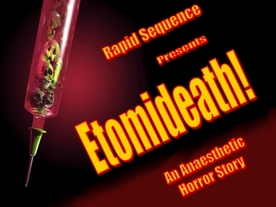
“Can I ask a bit more about etomidate as an induction agent? I’ve not actually seen it used yet.”
Silence descends upon the operating theatre. A peal of thunder rumbles ominously in the distance (I thought it was sunny!). Even the surgeons look up from the table, eyes widening above their facemasks. Someone drops a scalpel.
Etomidate Meta-Analysis: Critical Care Medicine
Tell Me About The Paper
What Did They Find?
With regards to adrenal suppression, the seven studies they used included 1,303 patients. Three of the studies were RCTs, three were retrospective studies and one was a prospective study. The results confirmed the relationship between etomidate and adrenal suppression in sepsis. The pooled risk ratio for these patients was 1.33, with 95% confidence intervals of 1.22 to 1.46.
On the surface of it then, some pretty compelling results about etomidate in sepsis. The relationship between etomidate and adrenal suppression was reconfirmed, with a demonstration of increased mortality too, something that the previous studies had failed to convincingly demonstrate. Let’s have a closer look at the paper and see what we can find, though I admit I am mainly limiting it to looking at the mortality side of things, given that this is the outcome that remains a bit contentious.
Is It Any Good?
The authors then go further from this starting point and apply multiple tests to their source information to further appraise its quality. I hadn’t heard of the Jadad scale prior to reading this paper, never mind the modified Jadad scale, but it is apparently a method of scoring papers to attribute a numerical value to their quality (based on blinding, randomisation etc. 1 is rubbish, 7 is great). This was one method the authors used to appraise their starting papers, going on to evaluate study heterogeneity, potential publication bias, and look at how study quality might affect the results by doing sub-group analysis.
Whilst a lot of this detailed analysis works to increase your confidence that etomidate does kill people, some of it urges a bit more caution. The analysis for potential publication bias is a notable point when the authors use the ‘trim and fill’ method to compensate for potential publication bias. If we include all five of the trials on mortality then it looks much the same, but if we are only looking at the four RCTs, the results slip back towards non-significance with a pooled risk ratio of 1.10 and 95% confidence intervals of 0.97-1.22. Is it just a case that there is a bit of publication bias with all the boring papers showing etomidate is safe languishing in a draw somewhere?
Final Thoughts
I wanted to wrap up with a few thoughts that I have borrowed from some of the people I have been talking to about this. I think perhaps the most important question to ask is: do the known benefits outweigh the potential risks? The overwhelming answer I’ve got back is no. Ketamine seems to be shamelessly hogging the limelight for these sorts of patients at the moment, again for its favourable cardiovascular profile, but I'm repeatedly told by my consultants that even careful and appropriate use of the core induction agents (thio and propofol) can minimise the cardiovascular insult of induction. If we can use these, why do we need to take the risk of using etomidate?
Tom Heaton
Intubation, Hypotension and Shock - The LITFL page on induction of the shocked patient.
 RSS Feed
RSS Feed
